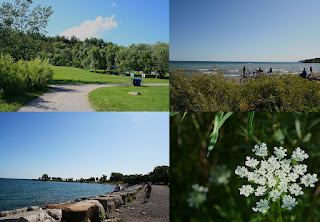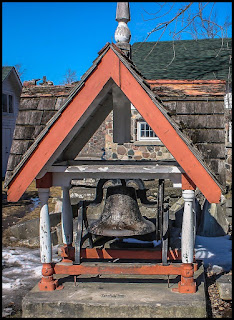 |
| Entering Bluffers from Brimley Road south |



 One of the first views while descending into Scarborough Bluffs Park (the "Bluffs") from Brimley Road, will be the awesome view of Lake Ontario as well as the colourful masts of the Yachts below lined row by row. The Bluffs is an escarpment in Toronto, Ontario which forms most of the eastern portion of Waterfront Trail. At one point the escarpment is as high as 65 metres (215ft) and spans more than 14 kilometres (8.5 miles). There are views from the escarpment that look as though you aren't in Toronto anymore, but rather some rugged coast land in England or Scotland. I imagine this is where Elizabeth Simcoe (wife of John Graves Simcoe) was inspired to name the area 'Scarborough' after 'Scarborough, England' when they settled in Toronto in 1793.
One of the first views while descending into Scarborough Bluffs Park (the "Bluffs") from Brimley Road, will be the awesome view of Lake Ontario as well as the colourful masts of the Yachts below lined row by row. The Bluffs is an escarpment in Toronto, Ontario which forms most of the eastern portion of Waterfront Trail. At one point the escarpment is as high as 65 metres (215ft) and spans more than 14 kilometres (8.5 miles). There are views from the escarpment that look as though you aren't in Toronto anymore, but rather some rugged coast land in England or Scotland. I imagine this is where Elizabeth Simcoe (wife of John Graves Simcoe) was inspired to name the area 'Scarborough' after 'Scarborough, England' when they settled in Toronto in 1793.  |
| View from east end of Bluffs |
It's a geological wonder. The escarpment formed the old shoreline of Glacial Lake Iroquois which appeared after the last ice age. When you are up close to the escarpment you can see it looks like clay which has been baked and cracked. In fact parts of the 'alluvial deposits" which are sediments that have been reshaped by the water, had settled westward to form the Toronto Islands that exist now.
 |
| Dunkers Flow Balancing System |
 |
| Different areas of Bluffers Park |
 |
| Alluvial deposits |
 Bluffers Park has a Restaurant, Yachting Clubs, Boat ramps, a Public beach and Picnic facilities and on any given pleasant day, you will most likely see gatherings of people,
having picnics, sailing, or hiking through the many trails
north of the lake closer to the bluffs, where there is an overgrowth of
wildflowers and hidden coves.
Bluffers Park has a Restaurant, Yachting Clubs, Boat ramps, a Public beach and Picnic facilities and on any given pleasant day, you will most likely see gatherings of people,
having picnics, sailing, or hiking through the many trails
north of the lake closer to the bluffs, where there is an overgrowth of
wildflowers and hidden coves. Keep in mind though there are plenty of access points along the escarpment where there are no barriers, and erosion does occur along the edges and certain conditions like rain or snow can make the clay-like sandstone extremely slippery when wet. Common sense takes precedence over curiosity here. Especially since there are so many vantage points along the bluffs for great views without risking your life to do it :)












